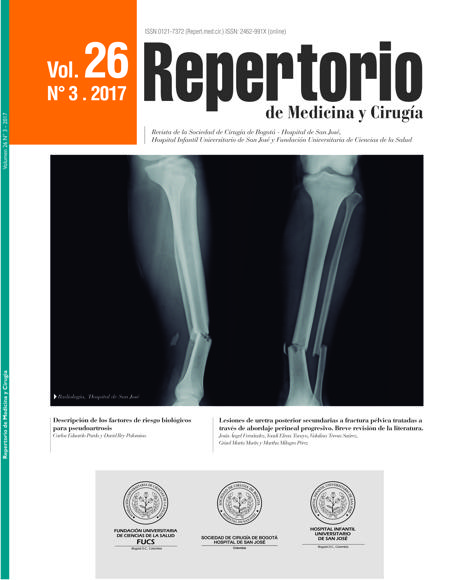Descripción de los factores de riesgo biológicos para seudoartrosis
Description of the biological risk factors for pseudarthrosis
Cómo citar
Descargar cita
Esta obra está bajo una licencia internacional Creative Commons Atribución-NoComercial-CompartirIgual 4.0.
Mostrar biografía de los autores
Objetivo: Describir las características clínicas y quirúrgicas que pueden catalogarse como factores de riesgo biológico en el desarrollo de seudoartrosis en los pacientes con fracturas de tibia y fémur tratados con o sin cirugía.
Materiales y métodos: Estudio de corte transversal; se revisaron los factores de riesgo biológico en seudoartrosis por fracturas de tibia y fémur en las historias clínicas de los hospitales de San José e Infantil Universitario de San José de Bogotá, Colombia. Se utilizó estadística
descriptiva para el análisis.
Resultados: Se incluyó a 91 pacientes tratados inicialmente con osteosíntesis. De los factores de riesgo evaluados, el 41,8% fue fumador, el 8,9% consumió medicamentos asociados con el riesgo de desarrollar seudoartrosis y el 8,8% presentaba alguna comorbilidad. El tutor externo fue el tipo de osteosíntesis más usado (37,4%). La mediana de tiempo para la cura de seudoartrosis fue de 9 meses (IQR 6-11).
Discusión: Los factores que afectan al proceso de consolidación se clasifican en mecánicos y biológicos. Como fortaleza se destaca que es el primer reporte local sobre los factores de riesgo biológico, excluyendo los de tipo mecánico, que pueden contribuir por otras vías a la generación de seudoartrosis.
Conclusión: Al identificar y conocer los factores de riesgo biológicos para el desarrollo de esta patología, se puede lograr una intervención temprana que defina la terapia apropiada y favorezca un buen pronóstico.
Visitas del artículo 958 | Visitas PDF 380
Descargas
1. Brinker M, O’Connor DP. Nonunions:evaluation and treatment. En: Brower B, Jupiter J, editores. Skeletal trauma, basic science, management and reconstruction. 5th ed. Philadelphia, PA: Saunders Elsevier; 2015. p. 637–718.
2. Megas P, Syggelos SA, Kontakis G, Giannakopoulos A, Skouteris G, Lambiris E, et al. Intramedullary nailing for the treatment of aseptic femoral shaft non-unions after plating failure: Effectiveness and timing. Injury. 2009;40:732–7. Epub 2009/04/16.
3. Cleveland KB. Delayed union and nonunion of fractures. Campbellı́s operative orthopaedics. 12th ed. Philadelphia: Elsevier; 2013. p. 2981–3016.
4. Lynch JR, Taitsman LA, Barei DP, Nork SE. Femoral nonunion: Risk factors and treatment options. J Am Acad Orthop Surg. 2008;16:88–97.
5. Rodriguez-Merchan EC, Forriol F, Nonunion:. General principles and experimental data. Clin Orthop Relat Res. 2004;419:4–12.
6. Babhulkar S, Pande K. Nonunion of the diaphysis of long bones. Clin Orthop Relat Res. 2005;431:50–6.
7. Cebrián JL, Gallego P, Francés A, Sánchez P, Manrique E, Marco F, et al. Comparative study of the use of electromagnetic fields in patients with pseudoarthrosis of tibia treated by intramedullary nailing. Int Orthop. 2010;34:437–40. Epub 2009/05/22.
8. Khan MS, Rashid H, Umer M, Qadir I, Hafeez K, Iqbal A. Salvage of infected non-union of the tibia with an Ilizarov ring fixator. J Orthop Surg (Hong Kong). 2015;23:52–5.
9. W-Dahl A, Toksvig-Larsen S. Cigarette smoking delays bone healing: A prospective study of 200 patients operated on by the hemicallotasis technique. Acta Orthop Scand. 2004;75:347–51.
10. Niu Y, Bai Y, Xu S, Liu X, Wang P, Wu D, et al. Treatment of lower extremity long bone nonunion with expandable intramedullary nailing and autologous bone grafting. Arch Orthop Trauma Surg. 2011;131:885–91. Epub 2010/12/17.
11. Gelalis ID, Politis AN, Arnaoutoglou CM, Korompilias AV, Pakos EE, Vekris MD, et al. Diagnostic and treatment modalities in nonunions of the femoral shaft: A review. Injury. 2012;43:980–8. Epub 2011/07/08.
12. Benazzo F, Mosconi M, Bove F, Quattrini F. Treatment of femoral diaphyseal non-unions: Our experience. Injury. 2010;41:1156–60. Epub 2010/10/13.
13. Kempf I, Grosse A, Rigaut P. The treatment of noninfected pseudarthrosis of the femur and tibia with locked intramedullary nailing. Clin Orthop Relat Res. 1986;212:142–54.
14. Marsh JL, Buckwalter JA, Evarts CM. Delayed union, nonunion, malunion and avascular necrosis complications in orthopaedic surgery. 3th ed. Philadelphia: JB Lippincott; 1994. p. 183–211.
15. Sen C, Eralp L, Gunes T, Erdem M, Ozden VE, Kocaoglu M. An alternative method for the treatment of nonunion of the tibia with bone loss. J Bone Joint Surg Br. 2006;88:783–9.
16. Papineau LJ, Alfageme A, Dalcourt JP, Pilon L. [Chronic osteomyelitis: Open excision and grafting after saucerization (author’s transl)]. Int Orthop. 1979;3:165–76.
17. Tu YK, Yen CY, Yeh WL, Wang IC, Wang KC, Ueng WN. Reconstruction of posttraumatic long bone defect with free vascularized bone graft: Good outcome in 48 patients with 6 years’ follow-up. Acta Orthop Scand. 2001;72: 359–64.
18. Angeli A, Guglielmi G, Dovio A, Capelli G, de Feo D, Giannini S, et al. High prevalence of asymptomatic vertebral fractures in post-menopausal women receiving chronic glucocorticoid therapy: A cross-sectional outpatient study. Bone. 2006;39:253–9. Epub 2006/03/30.
19. Giannoudis PV, MacDonald DA, Matthews SJ, Smith RM, Furlong AJ, de Boer P. Nonunion of the femoral diaphysis. The influence of reaming and non-steroidal anti-inflammatory drugs. J Bone Joint Surg Br. 2000;82:655–8.
20. Oh JK, Bae JH, Oh CW, Biswal S, Hur CR. Treatment of femoral and tibial diaphyseal nonunions using reamed intramedullary nailing without bone graft. Injury. 2008;39:952–9. Epub 2008/06/24.









